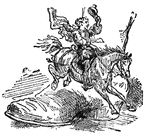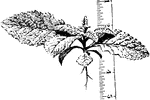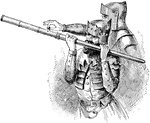
Queen looking in a mirror
The Queen of brobdignag quickly becomes fond of Gulliver. She holds him in her hand showing him around…
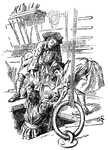
Gulliver Climbing Out
Gulliver is discovered at sea by a crew of Englishmen, who help him out of his box.

Hand Cultivator
The end of a hand plow. The metal part can be unscrewed and affixed to a hand plow, or left on the handle.

Hand Weeder
The hand weeder works on the same principle as the hand cultivator, but on a smaller scale. It is best…

Fort Fisher
"First assault upon Fort Fisher, Sunday, January 15th, 1865. The One Hundred and Seventeenth New York…

Billy Wilson Zouaves
"The ('Billy') Wilson Zouaves, at Tammany Hall, taking the oath of fidelity to the flag, April 24th,…

Continental Bills
Fac-simile of the Continental Bills. The paper on which these bills were printed was quite thick, and…

Vallisneria
Leaf, when examined with hand lends, showing a central dense and a peripheral less dense zone.

Society of the Cincinnati
"Society of the Cincinnati, member's certificate. This engraving is a fac simile of a certificate, about…
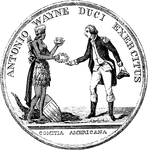
Wayne Medal Front
"Gold medal awarded by Congress to General Wayne. This is a representation of the medal, the size of…
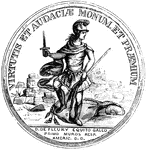
De Fleury Medal Front
"Medal awarded to Lieutenant-colonel De Fleury. This is a representation of the medal, the size of the…

Red Gurnard
"Twelve to sixteen inches long; it feeds on curstaceous animals; spawns in May or June; it is esteemed…
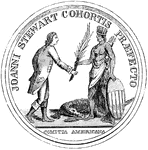
Stewart Medal Front
"Medal awarded to Major Stewart. This represents the medal the size of the original. The device is America…
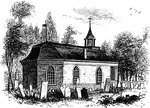
Sleepy Hollow Church
"Ancient Dutch Church in Sleepy Hollow. This view is from the church-yard, looking southwest. The porch…
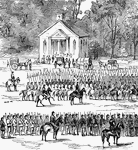
Battle at Willis Church
"Battle at Willis Church, Monday, June 30th, 1862- the Federal forces, under General Heintzelman, engaged…
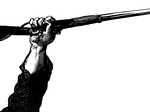
Hand with Gun
"Picture of a hand with a gun at the Battle of Munfordville, Ky., Sunday, September 14th, 1862- the…
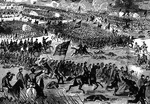
Battle of Champion Hills
"Battle of Champion Hills, May 16th, 1863- the formidable position of General Pemberton carried by Generals…
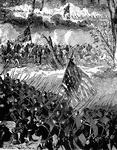
Battle of Champion Hills
"Battle of Champion Hills, May 16th, 1863- the formidable position of General Pemberton carried by Generals…
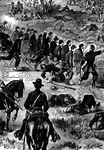
Battle of Champion Hills
"Battle of Champion Hills, May 16th, 1863- the formidable position of General Pemberton carried by Generals…
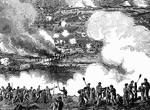
Battle of White Oak Swamp Bridge
"Battle of White Oak Swamp Bridge, Monday June 30th, 1862- Ayres's, Mott's and Randall's batteries checking…

Battle of White Oak Swamp Bridge
"Battle of White Oak Swamp Bridge, Monday June 30th, 1862- Ayres's, Mott's and Randall's batteries checking…
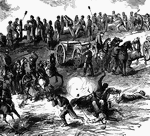
Battle of White Oak Swamp Bridge
"Battle of White Oak Swamp Bridge, Monday June 30th, 1862- Ayres's, Mott's and Randall's batteries checking…
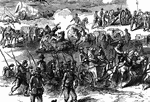
Battle of White Oak Swamp Bridge
"Battle of White Oak Swamp Bridge, Monday June 30th, 1862- Ayres's, Mott's and Randall's batteries checking…

Jamestown Island
"Distant view of Jamestown Island. This view is from the north side of what was once a marsh, but now…
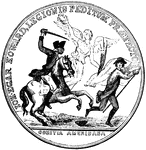
Howard Medal Front
"Silver medal awarded to Colonel Howard. The following are the device and inscriptions upon the front:…
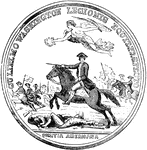
Washington Medal Front
"Silver medal awarded to Washington. The following are the device and inscriptions on the front: An…

Charlemagne
"Statue of Charlemagne, in Paris. At Pepin's death in 768 the kingdom of the Franks included the greater…
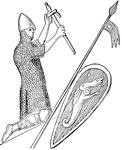
William the Conqueror
"William the Conqueror (1066-1087), as represented on his seal. Although William really ruled 'as king…

Charles I
"Charles I (1625-1649) was a far abler ruler than his father. He was a man of greater courage and more…

Blackspotted Pliers Support Beetle
"The Leptura Mordax, or Rhagium Mordax of Europe, three-fourths of an inch long,…

Aquarius
"A zodiacal constellation, supposed to represnt a man standing with his left hand extended upward, and…
!["Like that animal [the mole] it is constantly engaged in burrowing in the earth; and to enable it to do this with facility iits anterior limbs are converted into a pair of flat, fossorial organs, which are turned outward in exactly the same manner as the hand of the mole. In its pasage through the earth it does great injury to the roots of plants, but it said to live quite as much upon animal as vegetable food." — Goodrich, 1859](https://etc.usf.edu/clipart/14900/14935/molecricket_14935_mth.gif)
Mole Cricket
"Like that animal [the mole] it is constantly engaged in burrowing in the earth; and to enable it to…
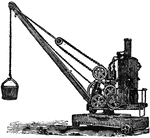
Steam Crane
"A Crane is a machine for lifting weights, worked either by hand or by steam, or by hydraulic power.…

17th Century French Fan
"A Fan is an instrument used by ladies to agitate the air, and cool the face, in warm weather; hence,…

18th Century Spanish Shell Fan
"A Fan is an instrument used by ladies to agitate the air, and cool the face, in warm weather; hence,…

Steam Fire Engine
"A Fire Engine is a machine employed for throwing a jet of water for the purpose of extinguishing fires.…
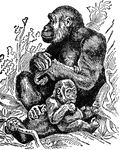
Female Gorilla
"The Gorilla is a celebrated anthropoid ape, generally belived to come nearer than any known one to…

Transverse section of the small intestine
"In the figure on the left are seen the artery and vein of a villus. In the right figure are represented…

Outer skin
"A Layer of the Outer Skin from the Palm of the Hand. Detached by maceration." — Blaisedell, 1904
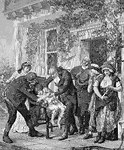
The First Vaccination
"This picture is based upon a photograph of a painting exhibited many years ago in the Paris Salon.…

Surface of the palm
"Surface of Palm of the Hand, showing Openings of Sweat Glands and Grooves between Papillae of the Skin.…

Superficial Nerves of the Forearm and Hand
"Superficial, or Cutaneous, Nerves on the Back of the Left Forearm and Hand." — Blaisedell, 1904
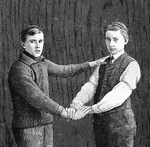
Hand seat
"Improvised Hand Seats: the Three-Handed Seat. THe usefull three-handed seat is made by one bearer grasping…

Hand seat
"Showing how the Improvised Three-Handed Seat may be used to carry an Injured Person. The picture also…

Palmistry
"Palmistry, or Chiromancy, is the art which professes to discover the temperament and character of anyone,…
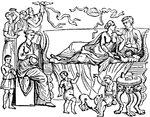
Accubatio
"The act of reclining at meals. The Greeks and Romans were accustomed, in later times, to recline at…
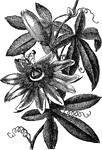
Passion Flower
"Pasiflora is the passion-flower. Generally climbing herbs or shrubs. Fruit succulent, seeds many. Found…

Ancile
"Ancilia carried by Salii. The sacred shield carried by the Salii, and made of bronze. The original…
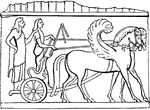
Antyx
"The rim or border of anything, especially of a shield or chariot. The trim of the large round shield…
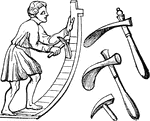
Ascia
"An adze. Muratori has published numerous representations of the adze, as it is exhibited on ancient…

Cantharus
"A king of drinking cup, furnished with handles. It was the cup scred to Bacchus, who is frequently…

Chirodota
"A tunic with sleeves. The tunic of the Egyptians, Greeks and Romans was originally without sleeves,…
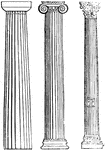
Columna
"A pillar or column. The use of the trunks of trees placed upright for supporting buildings, unquestionably…
